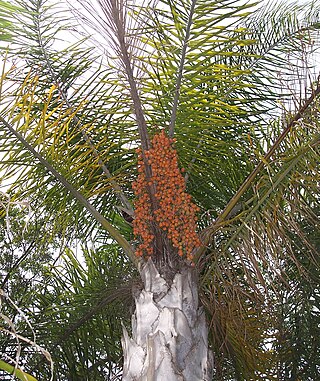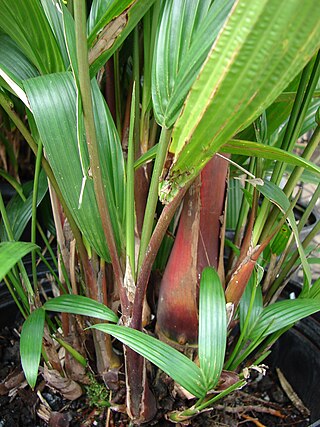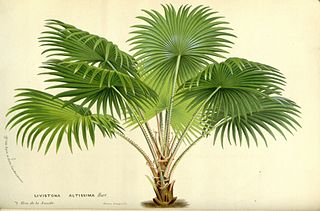
Areca is a genus of 51 species of palms in the family Arecaceae, found in humid tropical forests from the islands of the Philippines, Malaysia and India, across Southeast Asia to Melanesia. The generic name Areca is derived from a name used locally on the Malabar Coast of India.

Livistona is a genus of palms, the botanical family Arecaceae, native to southeastern and eastern Asia, Australasia, and the Horn of Africa. They are fan palms, the leaves with an armed petiole terminating in a rounded, costapalmate fan of numerous leaflets.

Syagrus is a genus of Arecaceae (palms), native to South America, with one species endemic to the Lesser Antilles. The genus is closely related to the Cocos, or coconut genus, and many Syagrus species produce edible seeds similar to the coconut.

Licuala is a genus of palms, in the tribe Trachycarpeae, commonly found in tropical forests of southern China, Southeast Asia, the Himalayas, New Guinea and the western Pacific Ocean islands.

Arenga is a genus of palms, native to Southeast Asia, southern China, New Guinea, and northern Australia. They are small to medium-sized palms, growing to 2–20 m tall, with pinnate leaves 2–12 m long. Arenga palms can grow in areas with little sunlight and relatively infertile soil.
Cyphosperma is a genus of flowering plants in the family Arecaceae, native to various islands of the Pacific. It contains the following species:

Cyrtostachys is a genus of flowering plant in the family Arecaceae. Its species are found in southeast Asia, New Guinea, and in some of the South-Central and Southwest Pacific island habitats of the Oceanian realm.

Neoveitchia is a genus of palm trees. It contains two known species, native to certain islands in the western Pacific:
Physokentia is a genus of flowering plant in the palm family, native to certain islands of the western Pacific.

Pinanga is a genus of flowering plant of the palm family in the subtribe Arecinae. It is native to eastern and southern Asia across to New Guinea.

Plectocomia is a genus of flowering plant in the family Arecaceae native to China, the Himalayas, and Southeast Asia. Plants are dioecious, with male and female flowers produced on separate individuals.

Ptychosperma is a genus of flowering plant in the family Arecaceae. Most are native to Australia and/or New Guinea, with a few in the Solomon Islands and in Maluku Province of eastern Indonesia. Some have been cultivated abroad as house or garden plants, and reportedly naturalized in certain regions.
Rhopaloblaste is a genus of flowering plant in the family Arecaceae, native to New Guinea, Melanesia and Southeast Asia.

Balaka is a genus of 9 known species in the palm family, Arecaceae or Palmae. Seven species are native to the islands of Fiji and two to Samoa. The genus was first proposed and published in Annales du Jardin Botanique de Buitenzorg 2: 91. 1885, from two species originally in the genus Ptychosperma.

Orania is a genus of the palm tree family Arecaceae, whose native is Madagascar, Malesia, and New Guinea.

Heterospathe is a monoecious genus of flowering plant in the palm family found in Oceania, where it is called sagisi palm. With 39 species, Heterospathe is named from a Greek combination of "various" and "spathe", which describes the two distinct bract types.

Hydriastele is a diverse and widespread genus of flowering plant in the palm family found throughout northern Australia, Melanesia, Polynesia, and Southeast Asia. It consisted of just nine species until 2004, when molecular research, supported by morphologic similarities, led taxonomists to include the members of the Gulubia, Gronophyllum, and Siphokentia genera. About 40 species are now recognized.

Saribus is a genus of palms, native to Southeast Asia, Papuasia and Pacific Islands. They are fan palms, the leaves with an armed petiole terminating in a rounded, costapalmate fan of numerous leaflets.

Linospadix monostachyos known as the walking stick palm is a small palm growing in rainforest understorey in Queensland and New South Wales.

Calyptrocalyx hollrungii is a palm species in the family Arecaceae, and is native to Papua New Guinea and to the Indonesian part of New Guinea, Western New Guinea.


















